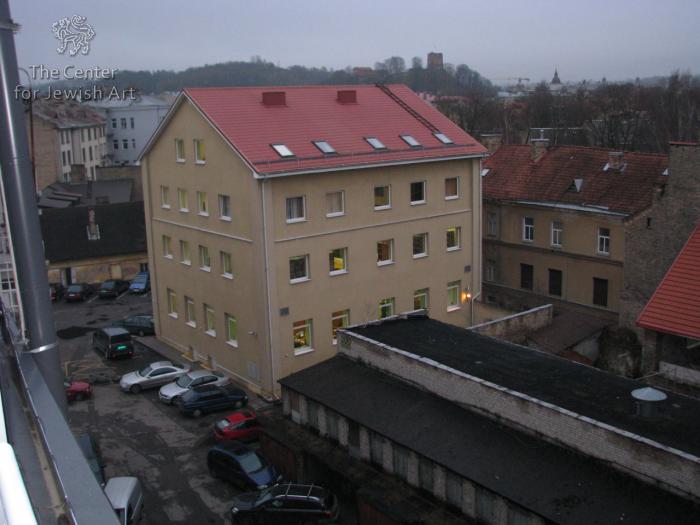Obj. ID: 14288
Jewish Architecture Green Bridge Beit Midrash in Vilnius, Lithuania

The beit midrash was called Briker kloyz in Yiddish, i.e. the kloyz near the bridge. A “large masonry” beit midrash was built around 1860 by the rich timber merchant Katriel Moshe Sheinuk (1832–90) on his plot near the Green Bridge. In 1904 it was called the “new prayer house, without a name;” the epithet “new” still functioned in 1915, while ca. 1920 its name was registered as Sheinuk’s Kloyz. Before WW I there were about 70 regular worshippers donating to the kloyz, while in 1916, 20 worshippers were “paying” and 35 others were “not paying.” The kloyz possessed also a small house in the same courtyard. In 1935 there were 57 worshippers. By 1942 the kloyz was damaged.
The building of the beit midrash is preserved but has been heavily reconstructed. Originally it was situated in a courtyard, accessed through a passage from 45 (today 2) Vilniaus Street, but currently the building is open towards the Neris River. The beit midrash’s liturgical axis was directed toward the south with a slight turn to the east. An additional floor was added to the building in the 2000s; it is separated from the original two-storey structure by a horizontal molding. From the original features, the corner lesenes are preserved as well as the division into the prayer hall (three southern windows) and the women’s section with vestibule (two northern windows) on the western façade. In 2009, the former beit midrash houses the department of social care of the Embassy of theRussian Federationin theRepublicofLithuania.
sub-set tree:
Cohen-Mushlin, Aliza, Sergey Kravtsov, Vladimir Levin, Giedrė Mickūnaitė, Jurgita Šiaučiūnaitė-Verbickienė (eds.), Synagogues in Lithuania. A Catalogue, 2 vols. (Vilnius: VIlnius Academy of Art Press, 2010-12)
Marija Rupeikienė, Nykstantis kultūros paveldas: Lietuvos sinagogų architektūra (Vilnius, 2003), p. 105;
Leyzer Ran, Yerushalaim delita (New York, 1974), vol. 1, p. 104;
Vilna: A Jewish Community in Times of Glory and in Time of Destruction, YIVO Exhibition Catalogue (New York, 1960), p. 19, no. 149





















